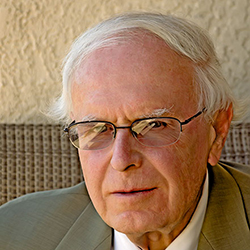Bažant Receives Honorary Doctorate from University of Minnesota
The honorary doctorate is Bažant’s eighth
Northwestern Engineering’s Zdeněk P. Bažant has received an honorary doctorate of science from the University of Minnesota.
Bažant, McCormick Institute Professor and Walter P. Murphy Professor of Civil and Environmental Engineering and (by courtesy) professor of mechanical engineering and materials science and engineering, was honored with a doctor of science for contributions to the knowledge base of engineering. This is the eighth honorary doctorate for Bažant, after receiving the distinction from institutions such as the University of Colorado, Ohio State University, and five European universities.
A member of the Northwestern faculty since 1969, Bažant’s research interests lie in new interdisciplinary problems of the mechanics of solids and structures, with applications in structural, mechanical, and aeronautical engineering, materials science, geophysics, and petroleum engineering.

Bažant is committed to ensuring that Northwestern faculty achieve research and teaching excellence for years to come. Through a major bequest in their estate, Bažant and his wife, Iva, a retired physician, will support Northwestern Engineering.
“Escaping from communism and coming to the US, and to Northwestern in particular, was the best decision of my life,” said Bažant, a native of Prague, Czech Republic. “I want to make sure that Northwestern continues to flourish, and that research and teaching in the fields of structural engineering and theoretical and applied mechanics, as well as mechanical engineering and materials science, remain strong.”
Bažant’s work has earned him several prestigious commendations. He’s a member of the National Academy of Sciences, National Academy of Engineering, and the Royal Society. He’s also a member of the national academies of Austria, Japan, the Czech Republic, India, Italy (Lincei), Greece, and Spain. In 2016, he received the Austrian Cross of Honor for Science and Art.
During his career, Bažant conducted research that resulted in findings such as:
- the size effect law for the fracture of concrete and other quasi-brittle structures, which is now embedded into the American Concrete Institute (ACI) design code governing all concrete construction
- the size effect method of testing fracture energy and material length, which is now an international standard recommendation (of RILEM).
- the crack band model for the numerical simulation of distributed cracking, which is now a mainstay of predictions of quasi-brittle fracture and strength scaling in concrete as well as airframes
- the age-adjusted effective modulus method for creep and a drying model for concrete, both featured in design codes and guides
- the “microplane” damage constitutive law that now runs on large wave codes in federal labs and various commercial software
- concrete creep laws with aging, solidification, nano-microprestress and hygrothermal effects, now used in ACI guides as well as international standard recommendations
- a model for fracture and size effect in fiber composites, which is used in design for crashworthiness of cars and airframes
- a stable testing method for fracture softening in fiber composites, for which he and four co-inventors secured a US patent
- the Gauss-Weibull and “fishnet” tail distributions of strength of quasi-brittle and architected materials needed to ensure the required safety
- a model for high-temperature creep, fracture and moisture transport in concrete, which is used in nuclear plant safety assessments
- a thermodynamically correct numerical analysis of stability and stress increments in inelastic solids under large deformations
- the invention (with three co-workers) of the “gap test,” which surprisingly revealed a major effect of crack-parallel stress on material fracture energy
- various useful mathematical results, such as an optimal numerical integration formula for a spherical surface, criteria for wave diffraction in non-uniform finite element meshes, stress singularity at the intersection of crack front edge with body surface; criteria for the stability of propagating crack systems and for branching of hydraulic cracks in shale, the isotherm of water sorption in gradually filling nanopores; and the theory of unsaturated nanoporomechanics
Bažant is well-known for his definitive analyses of the collapse of the World Trade Center towers on September 11, 2001, and the excessive deflection and consequent tragic collapse of the Koror-Babeldaob Bridge of record span length in Palau in 1996. His work has been implemented at structural engineering firms and companies such as Boeing, Chrysler, and Ford, and has improved the safety, sustainability, and efficiency of structures such as bridges, dams, buildings, aircraft, cars, ships, sea ice, and nuclear containments.
